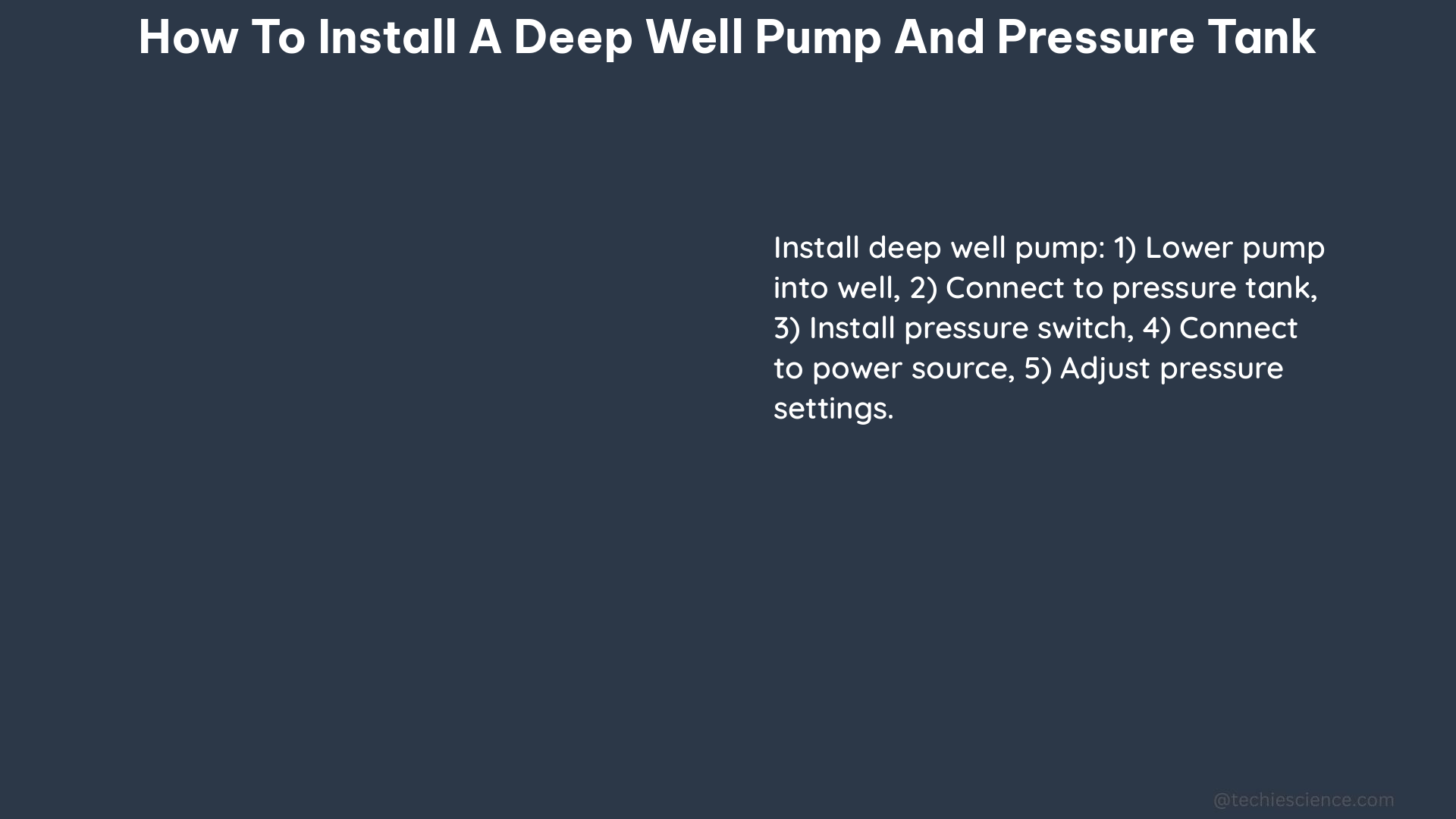Installing a deep well pump and pressure tank can be a complex task, but with the right knowledge and tools, it can be a manageable DIY project. This comprehensive guide will walk you through the process step-by-step, providing detailed information on the necessary components, measurements, and technical specifications to ensure a successful installation.
Choosing the Right Pump
The first step in the installation process is to select the appropriate pump for your deep well. For a well that is 200 feet deep, you will need a 230V pump with a minimum of 1/2 horsepower (HP). Stainless steel and brass pumps are generally more durable and reliable than those with plastic components, as they can withstand the high pressure and corrosive environment of a deep well.
When choosing a pump, consider the following specifications:
- Voltage: 230V
- Horsepower: Minimum 1/2 HP
- Material: Stainless steel or brass
It’s important to ensure that the pump you select is compatible with the depth of your well and can provide the necessary water flow and pressure to meet your household or property’s needs.
Installing the Pump

Once you have selected the appropriate pump, it’s time to install it in the well. The pump should be installed at a minimum of 5 feet off the bottom of the well, and ideally between 15-20 feet off the bottom for a 200-foot deep well. This will help to prevent the pump from being damaged by sediment or debris that may accumulate at the bottom of the well.
When installing the pump, consider the following measurements and specifications:
- Minimum distance from bottom of well: 5 feet
- Ideal distance from bottom of well: 15-20 feet
- Pump intake depth: Minimum 5 feet, ideal 15-20 feet
Ensure that the pump is securely installed and that all connections are tight to prevent any leaks or water loss.
Choosing the Right Pipe
The pipe that connects the pump to the well head should be made of 160 PSI rated PE polyethylene. This type of pipe is flexible, durable, and resistant to corrosion, making it an ideal choice for a deep well installation.
When selecting the pipe, consider the following specifications:
- Pipe material: 160 PSI rated PE polyethylene
- Pipe diameter: Typically 1-1/4 inch or 1-1/2 inch
- Pipe connections: Use couplers or fittings designed for PE polyethylene
Ensure that the pipe is properly secured and that all connections are tight to prevent any leaks or water loss.
Installing the Check Valve
The check valve should be installed as close to the pump as possible, to prevent water from flowing back into the pump when it is not in use. This will help to extend the life of the pump and prevent damage.
When installing the check valve, consider the following:
- Location: As close to the pump as possible
- Purpose: Prevent water from flowing back into the pump
Ensure that the check valve is properly installed and that the flow direction is correct, as indicated by the arrow on the valve.
Choosing the Right Pressure Tank
A pressure tank is typically used to regulate the pressure of the water supply. The size of the tank will depend on your water needs, but a 30-gallon tank is a good starting point for a small cabin or home.
When selecting the pressure tank, consider the following specifications:
- Tank size: 30 gallons (for a small cabin or home)
- Tank material: Steel or composite
- Tank pre-charge pressure: Typically 20-40 PSI
Ensure that the pressure tank is properly sized for your water needs and that the pre-charge pressure is set correctly.
Installing the Pressure Switch
The pressure switch should be connected to the pipe leading to the pressure tank, following the manufacturer’s instructions. This will allow the pump to turn on and off automatically as the pressure in the tank changes.
When installing the pressure switch, consider the following:
- Location: Connected to the pipe leading to the pressure tank
- Purpose: Automatically turn the pump on and off based on tank pressure
Ensure that the pressure switch is properly installed and that the settings are adjusted to your specific water needs.
Installing the Wiring
The pump will need to be wired to a power source, following the manufacturer’s instructions. Make sure to use appropriate gauge wire and to follow all local electrical codes.
When installing the wiring, consider the following:
- Power source: 230V
- Wire gauge: Appropriate for pump size and length of run
- Electrical code compliance: Follow all local electrical codes
Ensure that the wiring is properly installed and that all connections are secure to prevent any electrical issues or safety hazards.
By following these detailed steps and specifications, you can successfully install a deep well pump and pressure tank that will provide a reliable and efficient water supply for your home or property. Remember to always prioritize safety and consult with a professional if you have any doubts or concerns during the installation process.
Reference:
1. How to Install a Well Pump – The Home Depot
2. How to Install and Wire a Well Pump – Water Pumps Direct
3. DIY Deep WELL PUMP Installation from Start to Finish – YouTube

The lambdageeks.com Core SME Team is a group of experienced subject matter experts from diverse scientific and technical fields including Physics, Chemistry, Technology,Electronics & Electrical Engineering, Automotive, Mechanical Engineering. Our team collaborates to create high-quality, well-researched articles on a wide range of science and technology topics for the lambdageeks.com website.
All Our Senior SME are having more than 7 Years of experience in the respective fields . They are either Working Industry Professionals or assocaited With different Universities. Refer Our Authors Page to get to know About our Core SMEs.